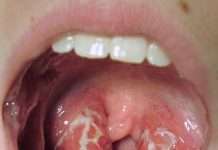
Diphtheria is an acute bacterial disease, caused by toxin-producing strains of Corynebacterium diphtheriae. The disease derives its name from the Greek “diphtheria”, which means “leather hide”. Hippocrates first described the disease in the 5th century BCE after which epidemics were described in the 6th century by Aetius.
Edwin Klebs first did the observation of the bacterium in diphtheritic membranes in 1883, while Friedrich Loffler carried out the cultivation in 1884. Diphtheria gained its official name from French physician Pierre Bretonneau (1778-1862), who called the disease diphtérite. Bretonneau also distinguished diphtheria from scarlet fever.
Prophylactic attempts against the disease were made in the early 1900s with combinations of toxin and antitoxin, leading to the development of the diphtheria toxoid in 1920. The toxoid was not widely used until 1930. It was subsequently incorporated into the tetanus toxoid and pertussis vaccine and became widely used in 1940.
Persons susceptible to diphtheria may acquire the toxigenic bacilli in the nasopharynx. The dangerous thing about the bacteria is that they produce toxins that inhibit cellular protein synthesis and are responsible for the destruction of local tissue and the formation of pseudomembrane which is characteristic of the disease.
The mechanism of damage caused by diphtheria involves the absorption of the toxins produced at the site of the membrane into the bloodstream from where they are then distributed to the tissues of the body. Major complications such as myocarditis, polyneuropathies, nephritis and thrombocytopenia are strongly linked to the toxins.
There are also non-toxin producing strains of C. diphtheria that can cause severe exudative pharyngitis. Other non-toxigenic strains of C. diphtheria are manifested in conditions such as cutaneous lesions, endocarditis, bacteremia, and septic arthritis.
Bretonneau recorded the first successful use of tracheotomy in a case of diphtheria. Having been used to treat other conditions, the procedure involves cutting an opening in the trachea and inserting a tube through the opening to allow passage of air and the evacuation of secretions. After Bretonneau’s several failed attempts in the use of this procedure had resulted in the death of patients, another French physician, Armand Trousseau (1801-1867), recorded a survival rate of about 25 per cent in the tracheotomies he performed on diphtheria sufferers.
Before vaccines for the disease were developed, diphtheria had been one of the most common causes of illness and death among children. Since the introduction of diphtheria vaccines in the 1920s and the implementation of universal childhood vaccination in the 1940s, the disease has been well managed in the United States and other countries of the world.
The successes recorded in the fight against the disease notwithstanding, diphtheria has continued to pose a public health threat, even in recent years. The World Health Organisation (WHO) had reported 10,107 cases in 2020. The figure showed a decline, compared to the number of cases recorded in previous years. However, it is believed that it was impacted by the COVID-19 epidemic.
Symptoms of diphtheria usually appear two to five days after infection and they include a thick grey-white coating that may cover the back of your throat, nose and tongue, a high temperature (fever) and sore throat. Others are swollen glands in the neck and difficulty breathing and swallowing.
The disease can be spread through coughs and sneezes or through close contact with someone who is infected. You can also get it by sharing items such as cups, cutlery, clothing or bedding, with an infected person.
In places with very poor hygiene, cutaneous diphtheria is common. Cutaneous diphtheria causes pus-filled blisters on the legs, feet and hands,as well as large ulcers surrounded by red, sore-looking skin.
Diphtheria can be treated with antibiotics, such as Penicillin and macrolide, which are groups of empirical antibiotics used to eradicate toxigenic C. diphtheriae based on the guidelines of the WHO and the Centres for Disease Control and Prevention (CDC). Treatment usually lasts two to three weeks. Any skin ulcers usually heal within two to three months but may leave a scar. Persons who have been in close contact with patients who have diphtheria may also need to take antibiotics or may be given a dose of the diphtheria vaccination.
Diphtheria vaccines are available and they help prevent an infection caused by Corynebacterium diphtheriae bacteria. There are four kinds of vaccines used in the United States today to help protect against diphtheria and all of them provide protection against other diseases. They are diphtheria and tetanus (DT) vaccines, diphtheria, tetanus and pertussis (DTaP) vaccines, tetanus and diphtheria (Td) vaccines and tetanus, diphtheria and pertussis (Tdap) vaccines.










